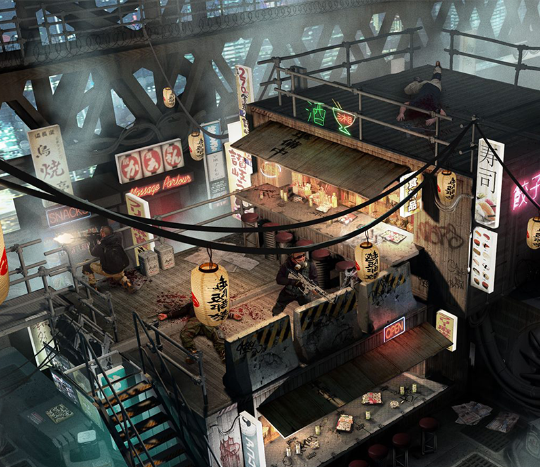During the long development of Dark Stars RPG, we made some mistakes in creating our systems and our settings for Dark Stars. We had several fairly amusing little hiccups in the process and some not so funny ones. There was a lot of frustration and tears, even some wailing and gnashing of teeth. Here are some examples of what we went through.
First of there was the combat system. Now we are all big fans of R. Talsorian games and Mike Pondsmith and we played a lot of Cyberpunk 2020, we had every book and consumed every piece of content that they produced. Now there are a lot of little things about the Fiday Night Firefight that don’t go smoothly in all situations, especially when it comes to automatic weapons and vehicle combat. It’s a fun, fast flowing combat system but in certain cases it breaks down. One of our stated goals was to make a combat system that was as realistic as possible and could be used for vehicle and personal combat seamlessly. So that’s what I did!
The mistake I made initially was to make the system too realistic. I had a system that assigned both a damage value and a penetration value to weapons based on the amount of kinetic energy they produced or the amount of joules an energy weapon produced. Then there was an adjustment to that based on the projectile characteristics for a projectile weapon or the pulse rate or burn-time of an energy weapon. Then we had an Armour Value for each type of armour and each type of damage; blunt impact, penetrating impact and energy damage. Then there was a simple equation that scaled the damage based on the comparative difference between the weapon’s penetration and the target’s relevant armour value, simple right?

In addition to a realistic approach to damage and penetration there was a realistic approach to wounds and death, if a character takes a bullet to the head then their one-way ticket is punched. In a fantasy setting there is usually magical healing but in a realistic setting without magic taking damage is terribly inconvenient for a character, realistic rates of healing mean that a character with a few bullet wounds could be out of the game for weeks of game time. We mitigate this with things like nanobots that heal a character and drugs that speed up natural healing but a bullet in the brain usually means it is time to roll a new character.
So feeling very proud of my brand new realistic combat system and confident that I had succeeded in the goal of making a combat system that was realistic and could be seamlessly applied to both shooting at vehicles and shooting at more squishy life forms, I ran a game.
The game went ok but the combats bogged down a bit, the players it seemed did not like to have to complete an algebraic equation to work out how much damage they di to the enemy. Also the realistic wounding was not too popular either and combat took to long to do as people struggled with the different armour values and the equation to work out the damage that went through the armour. In an attempt to alleviate the equation problem we created vast tables and colour coded all the damage types and penetration values so that a player could look up their result in a table without having to solve and equation. Well that bogged the game down even more than the equation ever did, so with great regret and a feeling of frustration I went back to the drawing board.
The take-away from the playtesting was that players didn’t really want realism no matter how much they said they did. Or at least they weren’t willing to deal with the level of complexity realism involves. Therefore the next order of business was to make the system more abstract, more streamlined. I rebuilt the entire combat system from the ground up, I ditched the different types of damage and the concept of some armours being better against different types of weapons. I ditched the concept of staged damage based on gradiated penetration vs armour values. I even ditched the whole system of damage calculation for weapons and went with an arbitrarily scaled system. The concept of multiple hits from a shotgun or fragmentation device? I ditched that too, everything that could contribute to bogging down a combat and get in the way of playing the game was ditched entirely.
My new concept was to make armour ablative, so the armour absorbs the round and is degraded, so a character was potentially bulletproof as long as their armour held out. The concept of penetration values of weapons was kept but that really is only there so we can have extremely high penetration weapons that can ignore personal armour. It’s silly that someone in body armour can take a hit from an anti-tank missile without taking damage, so anti-tank missiles have penetration values higher than any unpowered personal armour.
Well now we tested the new combat system and I was pleased to find that the games were much smoother, faster paced and a combat could be completed in much less time than before, leaving more time for roleplaying and adventure.
I guess the moral of the story is, the more realistic the system, the more complex it gets and the more complex it gets, the more time it takes for players to use it. The old adage that the simple things are often the best is applicable to game development just as much as to anything else.
In the next Blog I will talk about some of the problems we had in formatting the book and I will regale you with the tale of the missing mono-knife.
https://www.kickstarter.com/projects/darkstars/dark-stars




















